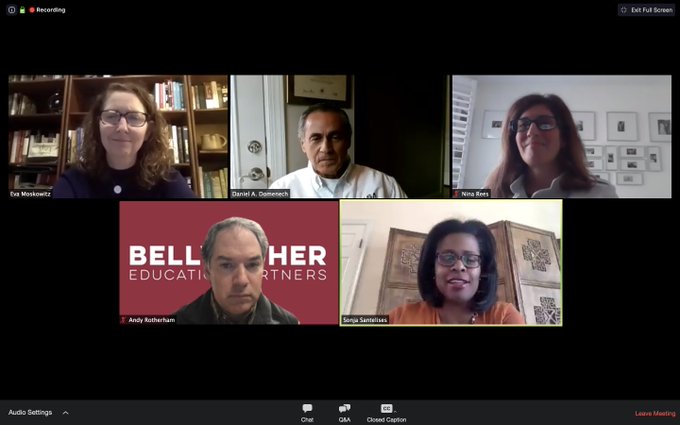Yesterday we hosted a robust webinar conversation about what’s been happening on the ground in American schools and what school leaders need to think about as they meet the remarkable challenges posed by COVID-19.
Bellwether’s Andy Rotherham shared the virtual stage with four pivotal sector leaders — Dan Domenech, American Association of School Administrators; Eva Moskowitz, Success Academy Charter Schools; Nina Rees, National Alliance for Public Charter Schools*; and Sonja Santelises, Baltimore City Public Schools — each of whom candidly talked about the challenges they’ve faced as school founders, district leaders, and organizational heads. While the conversation sometimes traced a grim reality, there were also shared stories of hopefulness, innovation, and success.

If you missed the webinar, a complete video recording with captions is available here and below:
Here are five key themes that came up in the conversation (quotes have been lightly edited for length and clarity):
Students’ humanity comes first.
- Sonja: We went to the essential first steps. For us it was feeding [our students]. For our community, we knew that was one of our first priorities.
- Eva: The communities we serve are the most impacted by the fatalities. So our crisis support has been in quadruple overtime just to support the deaths that our kids unfortunately are experiencing.
- Dan: Kids in poverty are dependent on the school in terms of being provided with a breakfast, a lunch and a snack…College-bound kids need to have grades, need to have transcripts, need to have a diploma to go to higher education.
COVID-19 is laying bare the inequities in our schools.
- Dan: This pandemic has exposed the problems with our school system and the inequity that exists among districts because of the way we fund education in this country. That has to be addressed first and foremost.
- Eva: Obviously [COVID-19] is unprecedented. But the schools were not in such great shape before all of this. There was a disparate quality of schooling. Our most vulnerable children were struggling to read and do math at grade level.
- Nina: It’s time to talk about one-to-one learning and the digital divide, which this crisis has brought to the forefront.
Access to technology is not the end of the road.
- Sonja: I resist and reject every kind of “do we do technology or do we do high-quality instruction” question. The technology is fabulous, but if you do not have a skilled educator who understands how to use it and knows their content deeply, you can keep your Chromebook and give me the high-quality teacher any day of the week. We’re going to have to have a both/and discussion, not an either/or.
- Eva: When I chaired the [New York City Council’s] education committee, I saw the district spend literally billions of dollars on technology, and it was not effectively used. Just because you have a one-to-one program does not mean you have a good curriculum.
- Nina: You can’t just give kids a computer and send them home. You need teacher training and parent training.
Don’t let perfect be the enemy of good.
- Sonja: We knew we were not going to get every family, every student, on day one, but that was not the license to say we’re just going to wait. What we became comfortable with very quickly was that different schools were in different places…We have been prioritizing our high school students, particularly our juniors and seniors, to make sure they have what they need in place for graduation.
- Sonja: We knew that our device-to-student ratio was one to four. So we were not going to be able to, with two days’ notice, go one-to-one. We immediately began to think about the other options for communicating across the district…One of our high school teachers posted on Instagram and got 85% of her students logging in with her because they follow her on Instagram.
- Eva: What we decided to do [in grades K-3] was really focus and prioritize reading.
Some shifts will — and must — carry through even after this crisis winds down.
- Sonja: One of the things we’re finding that doesn’t get talked about as much about is the number of our young people who are probably more engaged now because they have adults actually reaching out to them who care about where they are, and families who are being contacted in ways that they were never contacted before.
- Dan: I don’t think we’ll ever be back to the way it used to be. I think we’ve seen that online learning is the future. This is the time to move into the 21st century.
- Sonja: The willingness to be creative when you know everything is not perfect to me is where the pockets of promise are.
- Dan: We’re questioning some of the things we’ve been doing all along that we all of a sudden stopped doing. Guess what? The world didn’t end.
You can follow the conversation at #COVIDandSchools and see our other related resources here.
* National Alliance for Public Charter Schools is a former Bellwether client. We maintained full editorial control of this post.
